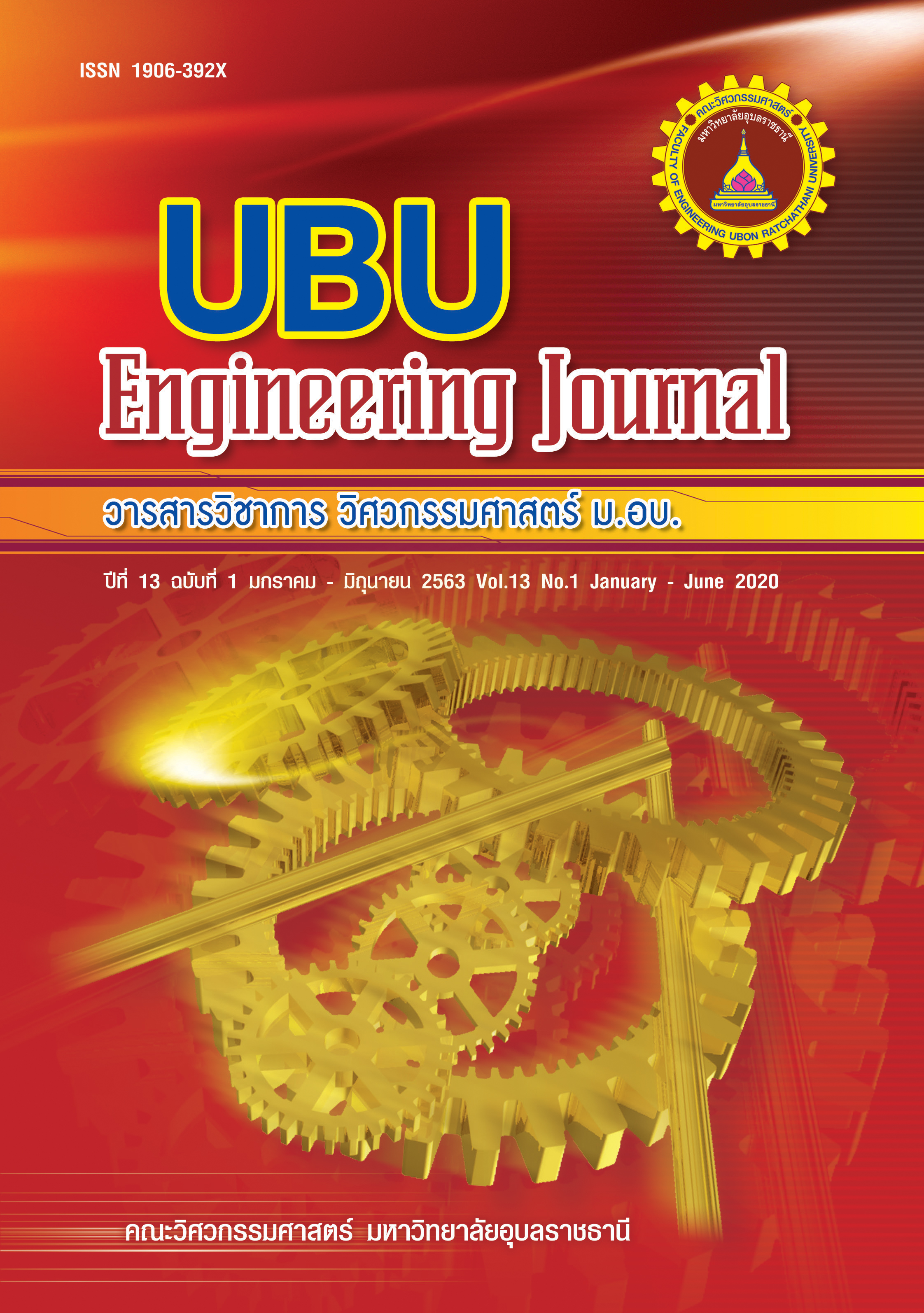การพัฒนาชุดปรับระยะเส้นไหมยืนในกระบวนการทอผ้าไหมด้วยเทคนิค ECRS
Main Article Content
Abstract
This study aimed at developing the warp yarn adjustment to increase the efficiency of silk weaving process efficiency of the silk weaving group in Surin province. The cause and effect diagram was used as research instrument to analyze the problems and the causes of the problem. The Failure Mode Effects Analysis (FMEA) was used as instrument for sorting the important level of causes of problems. The ECRS (Eliminate, Combine, Rearrange, Simplify) technique was used as tool for developing the warp yarn adjustment. The result of the warp yarn adjustment assessment showed that the low efficiency of the warp yarn caused by the inappropriate working mechanism and unbalanced of the yarn tension. The result of the developing of the warp yarn adjusting device showed that it reduced time for warp yarn adjustment at 121.45 seconds for each adjustment. The efficiency of the warp yarn adjustment increased for 71.53 percent and the tilt of the silk thread was reduced to 22.04 centimeters which could help reducing the warp yarn wasting for 403.2 meters and it was 97.39 percent per 10 sets of silk woven.
Article Details
References
[2] ธันยมัย เจียรกุล. “ปัญหาและแนวทางการปรับตัวของ OTOP เพื่อพร้อมรับการเปิด AEC”. วารสารนักบริหาร Executive Journal. 2557; 1: 177-191.
[3] Porter ME. The Competitive Advantage of
Nations. London: Macmillan; 1990.
[4] Suh, Y., & Kim, M. Internationally leading SMEs vs. internationalized SMEs: Evidence of success
factors from South Korea. International Business Review. 2014; 23: 115-129.
[5] Irjayanti, M., & Azis, A. M. Barrier factors and potential solutions for indonesian SMEs.
International Conference on Small and Medium Enterprises Development with a Theme
“Innovation and Sustainability in SME Development” (ICSMED 2012). Procedia Economics and Finance
[6] มาโนช ริทินโย. ปัจจัยที่ส่งผลต่อประสิทธิภาพการผลิตของวิสาหกิจชุมชนผ้าไหมทอมือจังหวัดนครราชสีมา. วารสารวิศวกรรมศาสตร์ มหาวิทยาลัยเชียงใหม่. 2560; 24: 180 -193
[7] มาโนช ริทินโย นิคม ลนขุนทด อรุณ อุ่นไธสง และ วิทยา อินทร์สอน. การพัฒนาเครื่องค้นหูกเส้นไหมด้วยเทคนิค ECRS. วารสารวิชาการวิศวกรรมศาสตร์ ม.อบ. 2560; 2: 52–61.
[8] Gaurav J. Pawar Nishant S. Sirdeshpande Aniket B. Atram and Prachi R. Patil. (2014). “Reduction in setup change time of a machine in a bearing manufacturing plant using SMED and ECRS”. : International Journal of Engineering Research, India. pp : 321-323.
[9] Sagar Waghambare Sunil Londhe Rupesh Rakibe Yashwant Nalawade Sneha Bire and Sachin Dixit. (2016). “Review on design and automation of axle assembly by using jig and fixture on conveyor process line”: International Conference on Emerging Trends in Engineering and Management Research, Anjaneri. pp. 95-104. Nashik.
[10] Shubham Kothavade and S.P. Deshpande. (2016). “Optimization of Scorpio front suspension (W105) assembly line by using ECRS Principles” : International Advanced Research Journal in Science, Engineering and Technology, Sangamner. pp. 26-20. India.
[11] Y. R. Wang. (2014). "Analysis and Optimization of Motor Assembly Process Flow", Advanced Materials Research. Vols. 926-930. pp. 747-750.
[12] Obi, O.F. The role of ergonomics in sustainable agricultural development in Nigeria. Ergonomics SA 27.1 (2015): 33+. Academic One File. Web. 2 July 2016.
[13] คลอเคลีย วจนะวิชากร ปานจิต ศรีสวัสดิ์ วรัญญู ทิพย์โพธิ์. การปรับปรุงประสิทธิภาพกระบวนการผลิตเพื่อลดความสูญเปล่าและเพิ่มคุณภาพผลิตภัณฑ์ เครื่องปั้นดินเผา กรณีศึกษาชุมชนเครื่องปั้นดิน เผาปากห้วยวังนอง จังหวัดอุบลราชธานี.วารสารวิชาการวิศวกรรมศาสตร์ ม.อบ. 2559; 2: 38–46.
[14] พัฒนา ปะหะกิจ และ อัมพิกา ไกรฤทธิ์. การบูรณาการ QFD และ FMEA เพื่อความพึงพอใจของลูกค้า กรณีศึกษาในอุตสาหกรรมยานยนต์.วารสารวิชาการเทคโนโลยีอุตสาหกรรม มหาวิทยาลัยราชภัฏสวนสุนันทา. 2560; 1: 13-23

